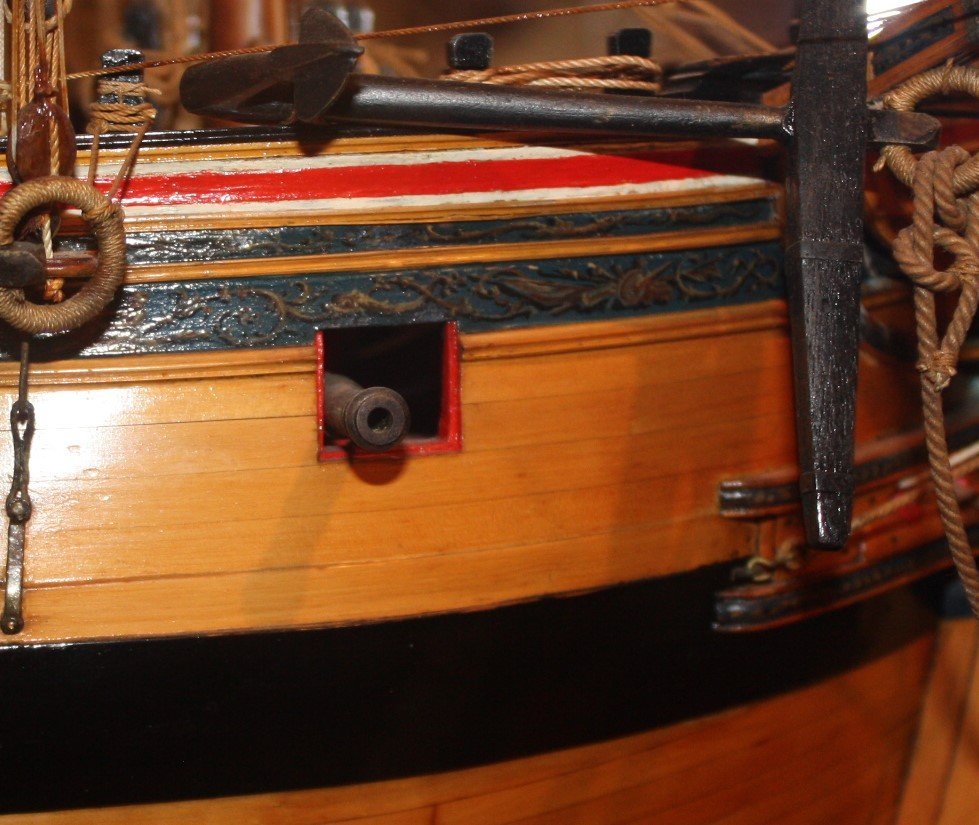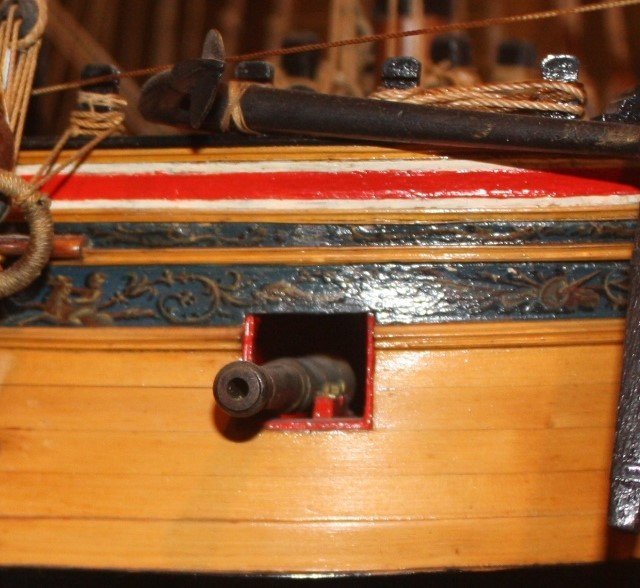-
Posts
8,119 -
Joined
-
Last visited
Content Type
Profiles
Forums
Gallery
Events
Everything posted by allanyed
-
It appears the kit is not without its challenges already but will you be marking out the lines of planking so you can accurately taper the hull strakes of planking? Then again, if Protector had a coppered bottom most of the planking below the wales will be covered. Allan
-

Kit Model or Plans for HMS Centurion 1732
allanyed replied to Fraser1945's topic in Wood ship model kits
There are all the deck plans for a 60 but it is a 1745 Establishment plan rather than 1719. ZAZ1907 at RMG Still it may be useful if coupled with the 1719 Establishment scantlings. It actually shows carlings and ledges, lodging and hanging knees as well as the beams which are not commonly shown. https://www.rmg.co.uk/collections/objects/rmgc-object-81698 Allan -
My fault Druxey. Just went with what I saw on line which I know is not always the best idea. 😕 From the American Bee Journal As beeswax is the primary construction material of the beehive, its chemical composition is integral to how the hive functions. This same material, the storage location of food resources and developing brood, must be relatively non-reactive, so beeswax's neutral pH (7) suits the need perfectly.Aug 1, 2015 Allan
-
The material of your rigging line will be part of the equation. In general a wax with neutral pH is best. As paraffin is alkaline (pH of 9) it could affect the longevity of the fibers. How much depends on the type of rope you are using. Bees wax is typically pH neutral so may be a better way to go if you want to use wax. In either case, wax will hold dust and very difficult to clean so be sure your model is properly cased. There has been mention of conservator's wax, hopefully some members can shed more light. Allan
-

Period Scale Model Masting and Rigging Tables
allanyed replied to DaveBaxt's topic in Masting, rigging and sails
That is my take as well. Proportions of the foremast are the same proportions as the main mast. For example if the diameter of the main mast is one inch for every three feet of length of the main mast the diameter of the foremast is one inch for every three feet of length of the foremast. FWIW regarding accuracy the human eye can only perceive a dimension difference of about 0.1mm if the objects are within the same field of view. Allan -
For the first planking layer it is very forgiving as you can sand and fill. For the second layer, it it is not to be covered with a copper bottom you may want to study the four part video on proper planking by Chuck Passaro. https://www.youtube.com/watch?v=KCWooJ1o3cM Nearly all your planks appear to be lifted. Even with a more severe taper as Chris discusses, you can still get lift if the planks are not properly formed for the bend and so they all end at the rabbet rather than coming to a point and short of the rabbet at the stem. If the planks are preformed there is no need for nails. Finger pressure for 30-45 seconds if using PVA glue or a few seconds with CA is all that is needed. Allan
-
Nice neat work! One small thing, some blocks look to be upside down so the lines are running under the sheave and over the tail rather than over the sheave and under the crown. Sketch may be more clear than words. You can see that on a real block there is no room for the line to run under the sheave. For our purposes and scales these openings are usually just another hole drilled as the line covers it as it runs down but still the line should be in the upper holes. Allan
-
English and European boxwoods (I think both are called buxus sempervirens) are difficult to find and very expensive stuff if you do find some. Castello boxwood (Calycophyllum multiflorum) is great to work with but it is becoming harder to find and prices are up. One source (and I would confirm it is buxus sempervirens) is https://exoticwood.biz/ Allan
-

Hello from the Scottish North Coast
allanyed replied to Scottish Guy's topic in New member Introductions
Welcome to MSW Michael! Allan -

Kit Model or Plans for HMS Centurion 1732
allanyed replied to Fraser1945's topic in Wood ship model kits
Fraser There is a drawing of Centurion 1732 that was made in 1729 in the RMG Collections which shows the body plan that you can use to draw her frames (or bulkheads if you want to build plank on bulkhead rather than plank on frame.) It also has an inboard profile showing her inner works. It is low resolution but can be purchased in high resolution as a paper plan or digital. It can then be redrawn with CAD so you can use it for laser cutting for some parts. She was built to the 1719 Establishment so there are scantlings of all her parts which can be found in several books, including Scantlings of Royal Navy Ships. The 1719 Establishment can also be found in the appendices in Peter Goodwin's The Construction and Fitting of the English Man of War. There are a number of drawings of additional 60 gun ships built to the 1719 Establishment and 1745 Establishment in the RMG Collections. Allan -
The main wales on Victory are probably about 10" thick based on the Shipbuilder's Repository. The strakes below are down to about 6" thick. The thicker strakes were reduced in thickness to match the thinner strakes so they could fit into the rabbet. Hope this is a little more clear. Pic below may also help as you can see the wales get thicker as you move aft from the stem. Allan
-
I would trust contemporary based information before modern reproductions, even if it is the Victory. I do wonder if this is part of the current 10 year $5million pound project. It is great that they are doing this so she will be around for many more years. I have reached out to Andrew Baines asking about the linings. I HOPE he will respond. Allan
-
Chris, years ago I thought there was a stop on the top as well, but looking at contemporary models, only one of many that I have seen has a top lining. Personally I would not rely on modern day Victory as a consistently reliable source of information. It is truly a treasure trove of information, but maybe not perfect after all the rebuilds. TFFM goes into the linings in detail and the contemporary models verify this. In the end, doubtless few folks would notice or care. Allan
-
Hi Chris Maybe not too late, and maybe not that important but there were no port lid stops/linings on the top of the ports, only the bottom and sides. The ports were made up with the sills top and bottom and frames on the sides. Linings (only about 1.5" thick) were then nailed to the frames and and bottom sill only. See photos from Preble Hall below. Don't forget that the thickness of the wales at the rabbet at the stem was reduced to the same thickness of the adjacent planking so it would seat properly in the rabbet. It looks like you did that on one wale, but hard to tell from the angle of the photos. Allan
-
Hi Vaddoc, This is intriguing so some questions, I hope you don't mind. What scale(s)? 1mm is the equivalent of 1.9 inches so at 1:48 would be great for the hull planks. What is your sequence? I can visualize holding one plank of a given strake in place and drilling the first hole then screwing into the frame. Then drill and screw subsequent holes in that plank into each frame. That should be about 24 for a 30 foot piece of planking. Next would be remove one screw at a time and insert a treenail. With about 100 frames and 100 strakes of planking you are talking about doing this 10,000 times. I like the idea though and would like to know more about how you perform this. TIA Allan
-
This is indeed an interesting thread. There are several charts of ranging shot from carronades in The History of English Sea Ordnance, Volume 2, including two that show the weight of the charge. The first includes only 68 pounders and the tests had various powder charges from 4 to 6 pounds. The ranges included shots at elevations from point blank to 2 degrees with each size powder charge. I was fascinated that each of the charts show at least the first graze and one shows three graze yardages as well as final distance. There is a note in one chart from the Lefroy Memorandum Book No. 20 in the R.A. Library about the tests taken in 1798 at Woolwich in which their data shows distance only to the first graze. They defined one charge as including the powder at 1/12 the weight of the shot plus the shot and the wad. I suspect the 1/12 the shot weight is what you were looking for. Allan
-

Period Scale Model Masting and Rigging Tables
allanyed replied to DaveBaxt's topic in Masting, rigging and sails
While the program saves a ton of time and is a great tool for the most part, keep in mind the Danny Vadas program is based on James Lees ratios EXCEPT for the period 1670-1710. It is completely wrong for this time period and really should not be used. The math that Lees uses for his period is extremely accurate but would have been difficult, maybe impossible, for Danny to duplicate in his program. Allan
About us
Modelshipworld - Advancing Ship Modeling through Research
SSL Secured
Your security is important for us so this Website is SSL-Secured
NRG Mailing Address
Nautical Research Guild
237 South Lincoln Street
Westmont IL, 60559-1917
Model Ship World ® and the MSW logo are Registered Trademarks, and belong to the Nautical Research Guild (United States Patent and Trademark Office: No. 6,929,264 & No. 6,929,274, registered Dec. 20, 2022)
Helpful Links
About the NRG
If you enjoy building ship models that are historically accurate as well as beautiful, then The Nautical Research Guild (NRG) is just right for you.
The Guild is a non-profit educational organization whose mission is to “Advance Ship Modeling Through Research”. We provide support to our members in their efforts to raise the quality of their model ships.
The Nautical Research Guild has published our world-renowned quarterly magazine, The Nautical Research Journal, since 1955. The pages of the Journal are full of articles by accomplished ship modelers who show you how they create those exquisite details on their models, and by maritime historians who show you the correct details to build. The Journal is available in both print and digital editions. Go to the NRG web site (www.thenrg.org) to download a complimentary digital copy of the Journal. The NRG also publishes plan sets, books and compilations of back issues of the Journal and the former Ships in Scale and Model Ship Builder magazines.





